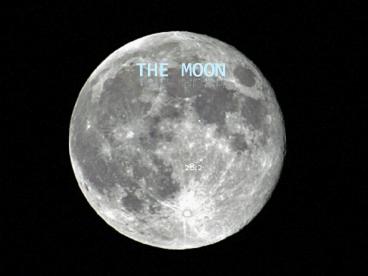The Moon - PowerPoint PPT Presentation
1 / 19
Title:
The Moon
Description:
28.2 Reaching for the Moon Much of our knowledge of the Moon comes from explorations by space probes and astronauts. The first step was taken in 1957 with the launch ... – PowerPoint PPT presentation
Number of Views:38
Avg rating:3.0/5.0
Title: The Moon
1
The Moon
- 28.2
2
Reaching for the Moon
- Much of our knowledge of the Moon comes from
explorations by space probes and astronauts. - The first step was taken in 1957 with the launch
of the first satellite, Sputnik I, by the Soviet
Union.
3
Reaching for the Moon
- In 1961, Soviet cosmonaut Yuri Gagarin became the
first human in space. - The United States Project Mercury launched the
first American, Alan Shepard Jr., into space on
May 5, 1961.
4
Reaching for the Moon
- Project Gemini launched two-person crews into
space, and on July 20, 1969, the Apollo program
landed Neil Armstrong and Buzz Aldrin on the
Moon, during Apollo 11.
5
Lunar Properties
- The Moons radius is about 27 of Earths radius,
and its mass is more than 1 of Earths mass. - Most moons are much smaller than this.
- The Moons orbit is relatively farther from Earth
than most moons are from the planets they orbit.
6
Lunar Surface
- The albedo of the Moon, the amount of sunlight
that its surface reflects, is very small (7). - The sunlight that is absorbed by the surface of
the Moon is responsible for the extreme
differences in temperatures on its surface. - 127C to -173C
7
The Lunar Surface
- There is no erosion on the Moon except for
impacts. - The surface of the Moon consists of several
features. - Regions called highlands are light in color,
mountainous, and heavily covered with craters.
8
The Lunar Surface
- Regions called maria (mare) are dark, smooth
plains. - All of the craters on the Moon are impact
craters, formed when objects from space crashed
into the lunar surface. - The material blasted out during these impacts
fell back to the surface as ejecta.
9
The Lunar Surface
- Some craters have long trails of ejecta, called
rays, that radiate outward. - Rilles are meandering, valleylike structures.
10
(No Transcript)
11
Composition
- The Moon is covered in minerals similar to those
of Earth, mostly silicates.
12
History of the Moon
- The Moon is between 3.8 and 4.6 billion years
old. - During its first 800 million years the Moon was
heavily bombarded which resulted into forming a
layer of loose, ground-up rock, called regolith
on the surface of the Moon.
13
History of the Moon
- After the bombardment, lava welled up from the
Moons interior and filled in the large impact
basins to form maria. - The Moon is twice as thick on the far side of the
moon.
14
Tectonics on the Moon?
- Scientists infer from seismometer data that the
Moon, like Earth, has a layered structure, which
consists of the crust, the upper mantle, the
lower mantle, and the core. - The Moon experiences a moonquake once a year, but
scientists theorize that the Moon is not
tectonically active.
15
Formation Theories
- The capture theory proposes that as the solar
system was forming, a large object ventured too
near to the forming Earth, became trapped in its
gravitational pull, and formed into what is now
the Moon. - The problem with that is that something would
have to slow it down, and the moon and earth
would have difference compositions.
16
Formation Theories
- Another theory, called the simultaneous formation
theory says the Moon and Earth formed at the same
time and in the same general area which makes the
materials the same. - This theory does not account for the different
amounts of iron on Earth and on the Moon.
17
Formation Theories
- The most commonly accepted theory of how the Moon
formed, the impact theory. - The Moon formed as the result of a gigantic
collision between Earth and a Mars-sized object
about 4.5 billion years ago, when the solar
system was forming.
18
Formation Theories
- As a result of the collision, materials from the
incoming body and from Earths outer layers were
ejected into space, where they merged together to
form the Moon.
19
(No Transcript)































